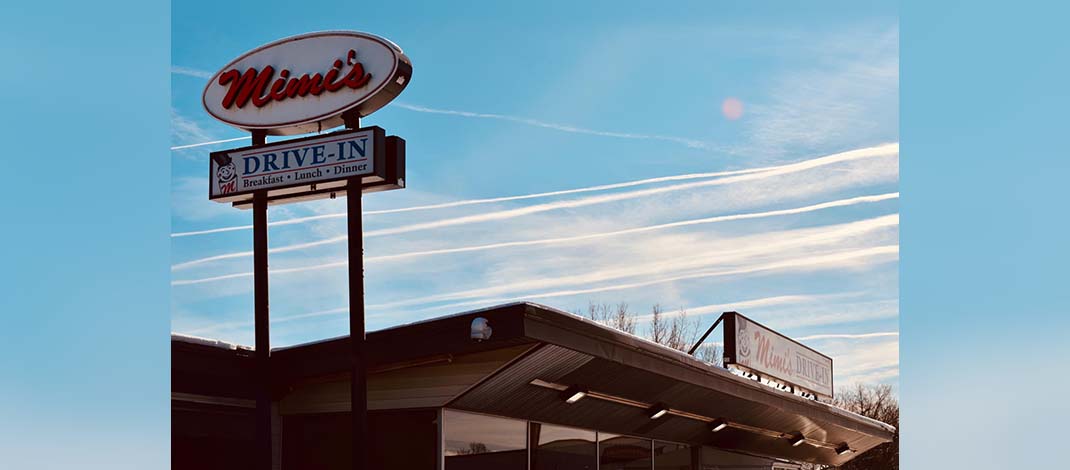By Deborah Jeanne Sergeant
While most restaurant patrons are accustomed to ordering delivery for pizza, Chinese food, sandwiches and a few other types of cuisine, their options widened considerably when the pandemic shut down in-person dining in 2020. Offering delivery provided a means for many eateries to continue to make money, even as virus-wary customers have begun to make their way back to the table.
Mimi’s Drive-In, a Fulton staple since 1970, still offers delivery. Co-owner Chris Sachel said that although it’s a small portion of his business, “We’re always looking for new revenue streams because business is tough, and we’ve always got to find any avenue to make a buck and keep people happy.”
The only way he would end delivery is if the employment issue worsens. He used DoorDash at one point. However, the fees it incurred cost him more money than he made. That is why employees handle delivery.
He tries to offer free delivery. However, he must charge $5 for orders less than $25 or the expenses of delivery gobble up his profit margin. Most people ordering delivery are in a group anyway, such as a doctor’s office ordering lunch for all the staff.
Sachel has also experimented with curbside pick-up, but his property’s layout made that option difficult. Curbside service requires designated parking spots and his lot has too many cars coming and going to make it work. Patrons struggled to understand the curbside concept and seemed more familiar with the restaurant’s take-out option.
For John Tassone, owner of Tassone’s Wine Garden in Baldwinsville, going with Grubhub made sense as staffing was already challenging. He began using the delivery service during the summer of 2020 and has continued. He is considering adding DoorDash in the future.
Tassone’s added curbside delivery, “a big hit, and we are still doing it,” Tassone said.
His customer base is aged 45-plus, people who tend to be more hesitant to eat out because of COVID-19. To reach a crowd more inclined to both use online ordering and to dine in the restaurant, he retooled his advertising to reach the 25-45 age crowd to build up that customer base.
“We’re starting to see more online ordering,” he said.
From early in the pandemic, the curbside and Grubhub orders have quadrupled, which Tassone said has helped keep the restaurant going.
Once pandemic restrictions have been lifted, he hopes to cease delivery services. While thankful that the delivery service has provided another means for customers to access his food, the fees take a big chunk of his profit.
“We’re starting to gain the parties we lost, like baby showers, bridal showers and large events,” he said. “It’s so nice for everyone to get together and enjoy themselves. We are social creatures and want to be around people. We really need to interact with people; we can’t go on just being sheltered.”
Fulton-based Bud Loura, owner of Restaurant QB, has more than 25 years’ experience consulting with independent restaurant and hospitality business owners in upstate New York and nationwide. He keeps in close contact of the restaurant industry in the area.
“The majority are not fans of delivery services,” Loura said. “They should do it themselves. Grubhub takes too much money.”
Loura said that for every $1 that goes in the register, the business makes four cents by the time the overhead is paid (although that overhead likely includes the owner’s salary). That thin profit margin can make adding and improving infrastructure or services very difficult.
He said that some restaurants shifted waitstaff to delivery positions, but the hours were not as plentiful. Loura also said that most restaurants in the area have been surviving on carry-out, which has doubled or tripled since before the pandemic.
The pandemic has also caused many in the restaurant business to cut back their operating hours.
“A lot of places are closing for days,” Loura said. “Some will never open for lunch again because it’s not economical and they saw it because of COVID-19. It’s too hard to staff.”
Many restaurants that had no online ordering have added that feature, many of them “old school people forced to do it,” Loura said. “Some are online only. You won’t be able to call in to place an order.”
He mentioned one restaurant so overwhelmed with call-in carryout orders that the kitchen became disorganized, serving walk-in customers immediately and subjecting call-in customers to longer waits. With online orders, they know how many orders are in the kitchen and can tell customers when theirs will be available.
“It’s a cleaner sale and more efficient,” he said. “They’re not overwhelming their staff. I’m surprised we haven’t seen more personal health of employees and owners go down. It’s challenging.”
Loura also said that more restaurants are embracing social media over print ads, as people staying home are in front of their computers and phones more than ever.
He envisions more “ghost kitchens,” where people can only order online and pick it up to go or have it delivered by employees or services like Grubhub, and there is no eat-in option.
More people cooking at home to save money and to replicate the cooking shows on television have also hurt the restaurant industry. Why go pick up chicken strips and fries at a restaurant when the air fryer does it at home for less?
Loura sees shorter hours as another long-term effect of COVID-19.
“I don’t think you’ll see a lot of 24-hour restaurants anymore,” he said. “People aren’t big drinkers as much anymore. Bars are closing at 10 or 11. There are fewer places to eat lunch. There is less staff. It’s a hard job and people have found other ways to make money.”
He said that fewer young adults want to work 40 hours a week but want only 25 to 30 hours so they have more free time. The increase in wages has prompted many chain restaurants to put in ordering kiosks.
“The jobs they’re replacing are not meant to support a family with,” Loura said. “It’s a starter job. It’s a high school or college-aged job. Eliminating these jobs makes it harder for your kids or grandkids to get a job. Everyone needs to enter the workforce and learn what it’s like to have a real job. I bet of the top 100 of the nation’s CEOs or COOs, about 50% likely had a fast-food job to start.”
“It’s so nice for everyone to get together and enjoy themselves. We are social creatures and want to be around people. We really need to interact with people; we can’t go on just being sheltered.”
John Tassone, owner of Tassone’s Wine Garden in Baldwinsville
Anthony Tringale owns Eat Local NY, an organization in Syracuse dedicated to promoting locally owned food-related businesses in New York State. He hopes delivery will continue, as it is now what customers expect.
“Customers know it costs more versus in-store and they’re still paying it,” he said.
Delivery services charge a fee of 20% to 30%. Add to that the fact that restaurant inputs have never been more expensive. The price of food and containers has risen, the latter because Styrofoam containers have been banned and replacement containers cost five to six times more.
“Everywhere they turn they’re getting hit,” Tringale said. “If restaurants don’t find ways to get food more accessible to customers, they’ll fail.”
He encourages local restaurants to obtain their supplies from nearby sources as much as possible, both to save money and also to keep their dollars local. Doing so can also generate more interest among consumers who prefer to buy local goods.
“Owners have to open their eyes and come up with innovative ideas to attract customers and make their food available,” Tringale said.
Featured image: Front facade of Mimi’s Drive-In in Fulton. Photo via Facebook.


